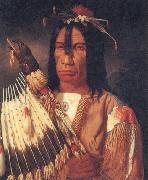Wholesale Oil Painting No Minimum |
|||||||||||
|
|
|||||||||||

|
|||||||||||
|
|
|
||||||||
John Kane1860-1934 American painter of Scottish birth. In 1879 Kane emigrated to western Pennsylvania. He worked as a bricklayer, coal miner, steel worker and carpenter in the Ohio River valley and, in 1890, began to sketch local scenery. After losing his leg in a train accident in 1891, he was employed painting railway carriages. When his son died in 1904, Kane left his family and spent years wandering and working in odd jobs; his earliest surviving paintings date from around 1910. Settling in Pittsburgh, he worked as a house painter and in his spare time painted portraits, religious subjects, the city's urban landscape and memories of his Scottish childhood. In 1927 the jury of the Carnegie International Exhibition, Pittsburgh, encouraged by the painter-juror Andrew Dasburg (b 1887), accepted Kane's Scene in the Scottish Highlands (1927; Pittsburgh, PA, Carnegie Mus. A.). Kane's success, at first considered a hoax by the press, was based on the modernist interest in primitive and folk art. His work was regarded as non-academic and boldly original, and he became the first contemporary American folk artist to be recognized by a museum. Larimer Avenue Bridge (1932; Pittsburgh, PA, Carnegie Mus. A.) is characteristic of his style with its meticulous detail, flat colour and dominant green and red. Though he sketched and painted on the site, Kane freely transposed pictorial elements to create a more pleasing composition. This innate compositional sense is evident in his Self-portrait (1929; New York, MOMA). |
||||||||
|
|
||||||||
Portrait of Kee-A-Keee-Ka-Sa-Coo-Way
Portrait of Kee-A-Keee-Ka-Sa-Coo-Way Painting ID:: 27904 |
1850-6
Oil on canvas,76.2 x 63.5 cm (30 x 25 in)
Royal Ontario Museum Toronto (mk63) 1850-6 Oil on canvas,76.2 x 63.5 cm (30 x 25 in) Royal Ontario Museum Toronto (mk63) |
|||||||
|
CONTACT US |

